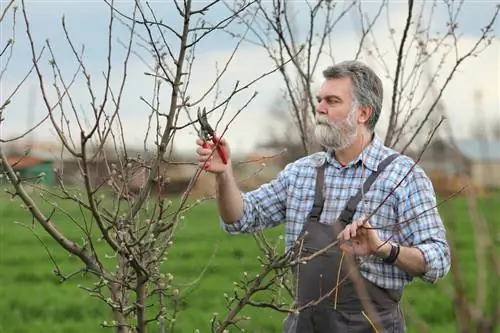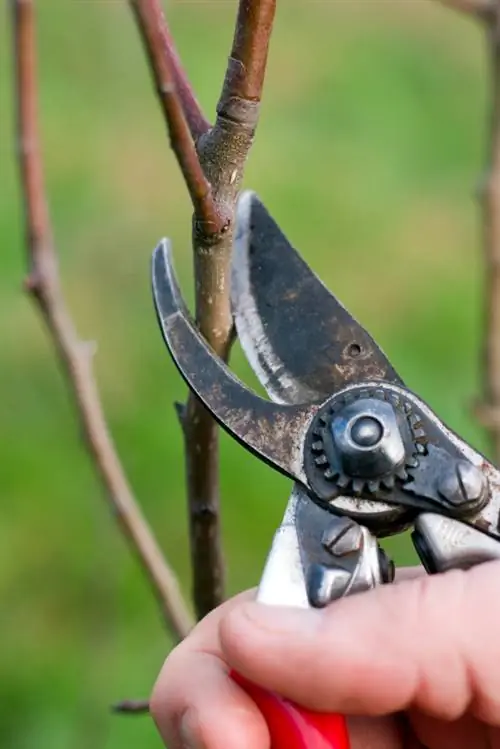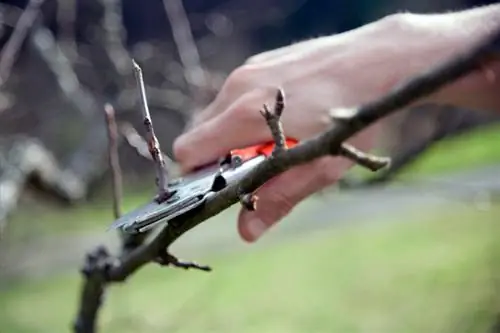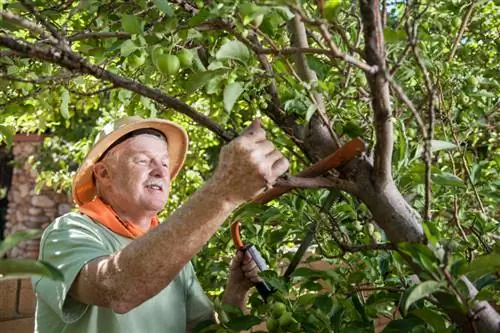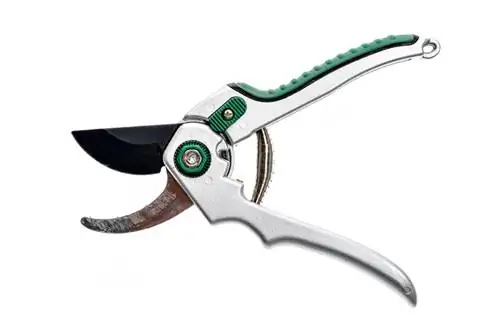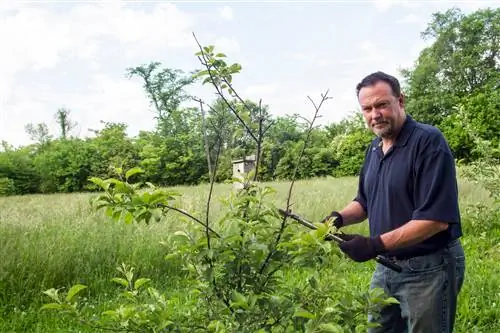- Author admin [email protected].
- Public 2023-12-29 04:51.
- Last modified 2025-06-01 06:02.
This tutorial gets beginners ready for the perfect apple tree cut. Practically tested instructions explain impeccable pruning care in every growth phase. Follow this educational path from planting pruning to successful training and productive maintenance to successful rejuvenation. Comprehensible information on the best dates, flawless cutting and recommended tools round off the basic knowledge.
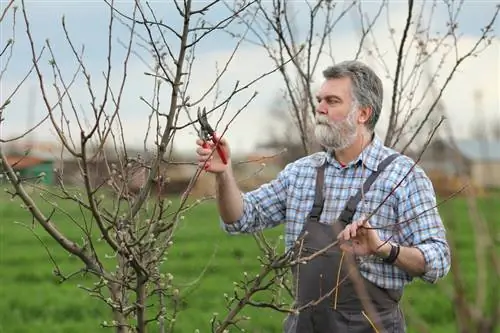
How should you prune an apple tree?
When cutting, remove weak shoots or competing shoots. Pruning gives young apple trees the desired crown shape. Older apple trees receive annual maintenance pruning, in which you only cut off old shoots.
All cutting types and dates in brief
Growing apple trees as standard or half-stem trees requires a few yearsPatience until the first harvest Depending on the height and apple variety, training extends over a period of 4 to 12 years. The effort is worth it, because with a well-shaped crown, an apple tree will provide you with crisp apples for many years without the need for extensive pruning. The crown is thinned out and the fruit wood is rejuvenated at intervals of 3 to 5 years. Strong-growing apple varieties benefit from soothing summer pruning, which also optimizes fruit quality. You can give an old, neglected apple tree new life with a strong rejuvenation cut. The following table summarizes all optional cutting types with information on the right time:
| Cut style | Goal/Occasion | best cutting date |
|---|---|---|
| Plant cutting | Building a sustainable, productive crown | after planting |
| Educational Cut | Building a sustainable, productive crown | in late winter from the 2nd year to the 4th to 12th year |
| Conservation cut | Dead wood, thin out water shoots, maintain crown shape, promote fruit wood | every 3 to 5 years in late winter from the 6th year onwards |
| Summer cut | Promote fruit quality and size | if required from the end of June |
| Rejuvenation cut | revitalize old apple tree | in winter |
The ideal time to prune fruit trees is controversially discussed among experts. Winter pruning measures are viewed critically because plants are dormant at this time and injuries cannot heal or can only heal slowly. From the perspective of labor economics and the Federal Nature Conservation Act, pruning care in winter is nevertheless mandatory, at least for extensive measures. This tutorial advocates the golden mean and recommends the profoundMaintenance and rejuvenation cutfor theWinter timeLightCare cutsto improve fruit quality are intended forSummer.
Plant pruning - How to prune professionally
Take your time when buying a young apple tree. A premium quality young plant has a straight trunk with five to seven annual shoots that are evenly arranged. In this way, you retain the option of selecting the best shoots for crown formation during planting. With the following planting cut you can set the course for a vital, productive apple tree with a well-formed crown:
- Determine the straight central shoot with 3 side shoots to form the future crown
- Ideal angle from side scaffold shoot to central shoot is 45° to 60°
- Cut off all remaining shoots on Astring
- Cut back strong leading branches by a third
- Short weak leading branches by half
- Prune a few millimeters abovean outward-facing budprune
- Prune the central shoot so that it is at an angle of 90° to 120° to the leading branches
Gardening enthusiasts often make mistakes when pruning plants. Usually too many scaffold shoots remain standing or the leading branches are not in the sap level. Last but not least, the recommended angle of 90° to 120° is not adhered to, so that the central shoot sits far too high above its leading branches, resulting in a pointed, high crown that produces little horizontal fruit wood.
Raising the apple tree crown to be productive
The extent of the training pruning depends largely on how your apple tree reacts to the planting pruning. Please act according to the rule of thumb: cut more heavily when there is weak growth and less when there is strong growth. In the natural garden we respect all plants as fellow creatures of nature, which react just as individually to external stimuli as humans do, only more slowly. Cutting instructions therefore do not work like the operating instructions for a machine. Rather, it specifies the optional framework conditions under which pruning care has a beneficial effect on growth and yield. Please first assess the individual growth of your apple tree and carry out the following training accordingly:
- Cut off competing shoots with central shoot on Astring
- Remove shoots growing inwards
- Cut away steep shoots on the leading branches at the base without damaging the bark
- Cut away branches sprouting from the central shoot below the crown
- Cut back theprevious year's growth on all 4 scaffold shoots by a third
- Important: Pay attention to the cut on buds (3-5 mm above an outward-facing bud)
As the illustration below shows, the training phase focuses on eliminating competing and steep shoots in favor of the crown shoots and their flat side shoots.
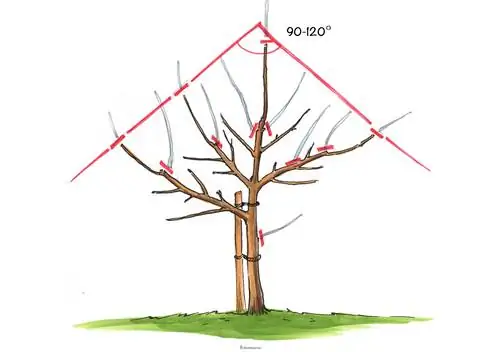
Train the crown of the apple tree to juice levels for optimal fruit yield. Three leading branches gather radially around a dominant central shoot, the tip buds of which are at the same height. Prune the central shoot so that its tip sits above the leading branches at an angle of 90 to 120°.
Excursus
Form unwilling guide branch by spreading it out
Popular apple varieties, such as 'Cox Orange', tend to have tightly upright, conical growth. This has the disadvantage of shaded crowns with little horizontal fruit wood and a very late start to the yield phase. By spreadingvertical leading shootsalready in theyouth phase, you increase the exposure area and direct the growth to a better angle for valuable fruit wood with numerous flower buds. The wood of elderberry and willow is perfect for this purpose. Notch the wood at both ends so that it rests firmly on the apple tree. Spread a leading branch that is too steep within an apple tree crown to an ideal inclination of 45° to the central shoot. Pay attention to the sap scale and the recommended angle of 90 to 120° from the central shoot to its leading branches.
Carry out maintenance pruning every 3 to 5 years
Premium quality fruit wood is found on the apple tree on 10 to 15 cm short fruit skewers, garnished with a flower bud and supported by perennial, slanting to horizontal fruit branches. Over the course of the following years, the fruit wood becomes increasingly branched and bears flowers and fruit every year. After 3 to 5 years, the fruit wood in the apple tree has worn itself out, hangs down unmistakably and is rejuvenated with the help of maintenance pruning. Since the crown has now branched intensively and numerous water shoots are sprouting, leafy branches shade each other. The cutting measure is therefore aimed at promoting young fruit wood and light-flooded growth. How to cut in an exemplary manner:
- The best time is in winter on a frost-free day
- First thin out dead wood, including all inwardly or steeply growing shoots
- Do not cut branches that grow diagonally
- Scaffold shoots with strongly branched tips lead to a deeper, young side shoot
- Rejuvenate recently removed, hanging branches using fruit wood cutting
The image below illustrates the cutting route as an example. It depends on your individual assessment how intensively you intervene in growth with scissors and saws. In the end, your apple tree should present itself with a light crown that has a balanced ratio of a supporting, long-lasting framework with slanted-horizontal fruit wood. The rule of thumb applies here: a fruit shoot is no more than half as thick as its supporting framework shoot. The advantage of cutting in late winter is that you can clearly see the swelling flower buds so you don't cut in these areas.
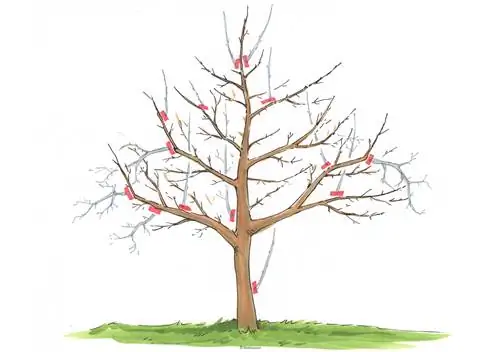
Prune your apple tree carefully every 3 to 5 years. Remove dead wood, vertical water shoots and shoots growing inwards. Drooping, heavily branched fruit wood is rejuvenated by a derivation cut.
How to achieve a professional fruit woodcut
In the last step of late winter preservation, the cut is dedicated to the removed fruit wood. While thinning out dead wood and unfavorable shoots is easy, cutting fruit wood can be a headache for beginners. For this reason, the important cutting technique is explained in more detail below:
- Identify old fruit wood by its pronounced hanging growth
- For the intersection point, select a slanting upward rider in the rear shoot area
- Cutting at the junction of old and young shoots
So that you do not injure the young fruit wood, please cut a few millimeters into the worn-out fruit shoot. The cut should not leave a stub that is too long, measuring more than 1 centimeter, as this could become a source of infection for pathogens. The image below shows the correct cut.

Fruit wood on the apple tree is not forever young and productive. After a slanted, upright youth phase, it bends downwards over time under its sweet burden. At the same time, further back on the shoot near the apex, diagonal young shoots form as future fruit wood. Where old and young fruit wood fork, the rejuvenating fruit wood cut begins.
Best fruit quality thanks to summer cutting
Towards the end of June (around St. John's Day on June 24th), trees take a short break in growth and then sprout again with reduced vigor. The following rule of thumb applies to pruning apple trees: winter pruning stimulates growth - summer pruning has a calming effect on growth. If strong growth is no longer desired on older apple trees and the quality of the fruit becomes more important, summer care pruning has proven useful in practice.
- Best time is mid to late July
- Postpone or cancel the appointment if birds nest in the apple tree
- Cut off shoots that are steep and grow into the inside of the crown at the base
- Do not intersect horizontal young shoots as future fruit wood
- Tear off wild shoots from a base or on the trunk with a twisting motion
An appointment in July is well suited to have a positive influence on the quality and size of apples. In the so-called June fall, an apple tree automatically releases fruit that is not or insufficiently pollinated. If there are still too many fruit plants on the wood, your intervention is necessary. The most promising apple is usually located in the middle of a fruit cluster. Remove all remaining fruits from the bush. Take this opportunity to select the bestfruit baseswithin the entire tree crown at aminimum distance of 3 centimeters Cut off all remaining and damaged fruits.
Background
Turn sterile shoots into fruit wood without cutting
The growth law of apex promotion teaches us that overhanging, curved shoots sprout most strongly from the buds at the apex. Strong, sterile wooden shoots without flower buds sprout in these places on the apple tree. Eyes positioned lower down are disadvantaged by the sap pressure, so that they transform into flower buds as a result of the poorer supply of nutrients. By bending atightly upright new shootand tying it to itshorizontal leading branch, you apply the law to transform sterile wood into fruiting wood. As the illustration below illustrates, the shoot in question must not be tied off too deeply. Rather, the targeted buds should be slightly above the horizontal.
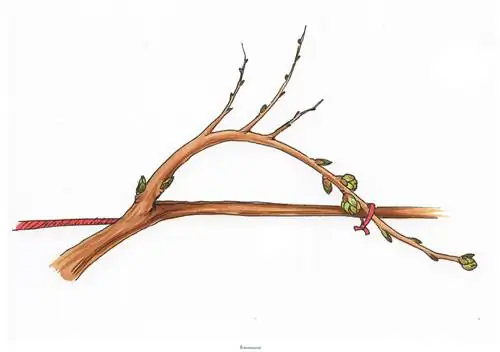
Promoting valuable fruit shoots can also be achieved without pruning. In March, bend down a he althy side branch and tie its end to the horizontal leading branch. The lowest eyes turn into flower buds, which give you juicy apples for one to two years.
Rejuvenate old apple trees - this is how it works
If maintenance pruning on the apple tree is neglected for many years, the crown turns into an impenetrable network of old and young shoots. The inside of the crown is permanently in shade, so that hardly any leaves grow here. Formerly vital fruit shoots hang massively over and bear few or no flowers or fruit at all. You can revitalize your sagging apple tree with the following rejuvenation cut:
- The best time is between November and February when the weather is frost-free
- Remove dead wood, weak and inward-facing branches to maintain a clear view of the crown
- Define a new framework consisting of a central shoot and three evenly distributed guide branches at the right angle
- Thin out all remaining branches on Astring
- Cut crown shoots back by half, ideally by directing them to a young, diagonal side shoot
Do you feel forced to cut out more than a third of the crown? Then we recommend a gradual rejuvenation cut over 2 to 3 years. This has advantages in several ways. In particular, an old tree can cope better with radical pruning. Furthermore, a less strong budding sets in, which you can control better.
Excursus
Strong pruning triggers massive sprouting - just don’t panic
The more radical you are with the rejuvenation cut, the stronger the subsequent growth will be. The massive growth causes concern for beginners in apple tree pruning care, because countless new shoots sprout from revitalized sleeping eyes. Instead of using the scissors in a panic, you should use the fresh growth specifically to rebuild. In the following late winter, remove half of all steep and inward-facing new shoots. Slanting to horizontal shootsleave as futurefruit wood. In the second winter after rejuvenation, remove the remaining steep shoots. Now transition the pruning care into a maintenance phase at intervals of 3 years, supplemented by a light summer pruning, as explained in this tutorial.
Recommended tools - tips for basic equipment
Safety is key when pruning apple trees. The premise applies equally to gardeners and trees. High-quality branded tools guarantee smooth cutting work and leave smooth cuts on the wood. Diseases and pests have no areas of attack if cutting edges, blades and saw blades are meticulously clean and disinfected. A sturdy ladder takes the fear out of climbing to lofty heights. The following basic equipment ensures a smooth cut in the apple tree:
- One-handed secateurs for shoot thicknesses up to 2 cm
- optionally as bypass or anvil scissors, for left- or right-handed people
- Two-handed pruning shears for shoot thicknesses of 2 to 4 cm (ideally with a power-enhancing ratchet gear)
- Sword or hacksaw for drive thicknesses of more than 4 cm
- Telescopic pruning shears for working up to 4 m high apple tree crowns
You can't always cut treetops from the ground with telescopic pruning shears. In this case, you should have a stable stepladder or folding ladder that has two legs that you can fold apart. This ensures more safety compared to a conventional leaning ladder, which only has one leg. Special fruit tree ladders consist of a leg and a leg as a support. The feet of the leg and support are equipped with metal tips to firmly anchor the ladder in the ground. An integrated sliding element allows extension up to the crown tip. Thanks to their conical shape, fruit tree ladders are suitable for uneven terrain and are also often used for trimming hedges.
Frequently asked questions
Our apple tree bears a lot of fruit every year. Unfortunately, he sheds all of them in June and July. What to do?
The dilemma described is typical of a tree with too many apples. Next year, remove half of the fruit base and check whether the other half of the apples remain hanging until they are ready for harvest. In addition, please ensure there is sufficient soil moisture. After a dry, hot period of weather, fruit drop can occur.
My apple tree will now be 3 years old in October, has never bloomed and is there early in the summer with dried leaves. Is the tree dead?
You can check by scraping off a little bark. If the tissue under the outer bark is still green, then your apple tree is alive and has simply begun its winter dormancy. Brown tissue indicates the tree is dead. As early bloomers, apples form their flower buds in late summer in order to unfold them in spring. For this reason, winter pruning should be carried out carefully. Furthermore, with standard trees it can take up to 8 years for an apple tree to bloom and fruit for the first time. Experience has shown that the flowers and apples appear as spindles or bushes from the second year onwards.
Can I put an apple tree in a large pot on the balcony?
Basically there is nothing wrong with keeping an apple tree in a pot. Popular varieties such as 'White Clear Apple', 'Gravensteiner' or 'Cox Orange' reach a height of 2 to 4 meters, which can cause space problems on a balcony. Furthermore, pollination is problematic because suitable pollinators should be 5 to 30 meters away. A columnar apple or dwarf apple is better suited for the bucket on the balcony.
5 years ago I planted an apple tree and gave it an annual pruning. Unfortunately, only leaves and no flowers still grow. Is the problem with the cut?
After planting and training, you should let an apple tree grow so that it can develop naturally. The pivotal point is to raise the shoots as horizontally as possible so that the fruit wood can form on them. Instead of cutting, you should spread the branches or tie them down. A thinning cut every 3 to 5 years is completely sufficient. From July onwards, the fruit wood on which the flowers and fruits thrive can form on the leading branches. When the yield phase begins depends, among other things, on the height of the trunk. An apple tree with a standard trunk takes 6 to 8 years, sometimes even 10 to 12 years, until the first apple harvest. Development takes 3 to 6 years on half-stems and 2 to 4 years on bushes.
3 years ago I planted an Elstar apple tree. It now bears so many apples in August that its branches bend to the ground and I have to support the branches to keep the tree from falling. When and how do I prune the apple tree?
So that the crown branches well, we recommend pruning vigorously in February/March. In this way, the tree builds a stable structure. It is important to note that you cut out branches that grow inwards. The remaining branches are shortened in length so that a stable, pyramidal crown is formed. Always cut 0.5 to 1 centimeter above an outward-facing bud. To ensure that the branches do not break under their weight this year and cause irreversible damage, we recommend shortening the shoots slightly now to relieve the strain on the apple tree.
The 3 most common cutting mistakes
An apple tree with dense leaves and few flowers or fruits suffers from a classic pruning error. The following overview lists the three most common mistakes when pruning apple trees and gives useful tips on how to avoid the mistakes.
| Cutting errors | malicious image | Prevention |
|---|---|---|
| leading branches that are too steep | dense, shady crown, few flowers and apples | Spread guide branches to an ideal angle of 45° |
| cut too much and too often | many leaves, few flowers and fruits | Let apple trees grow, cut every 3 to 5 years |
| never thinned and fruit wood rejuvenated | aged crown, old, rotten fruit wood | Tighten out and carry out fruit wood cutting every 5 years at the latest |
We don't want to hide another typical beginner's mistake from you here. There is great joy about a lush fruit set, but unfortunately it often results in premature fruit drop or measly apples. Even if it is difficult, you should thin out a fruit set that is too dense to a minimum distance of 3 centimeters.

Tip
Do not cut out every water shoot from an apple tree crown in winter. The potential for fruiting wood lies in a vertical shoot. The weaker the growth, the more promising it is to motivate a water shoot to flower by tying it down in a diagonal position.

